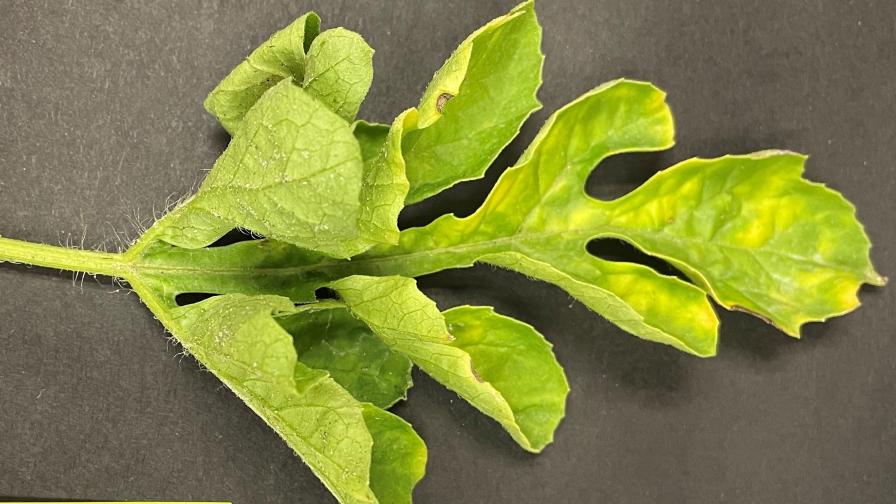2 Mystery Plant Viruses a New Worry for Watermelon Growers in Florida

This leaf tested positive for watermelon crinkle leaf-associated virus 1 (WClaV-1). Watermelon crinkle leaf-associated virus 1 and 2 can be tricky to spot due to mildness of symptoms and co-infection with other viruses.
Photo by Pamela Roberts
Florida watermelon growers are facing two new viruses in the field. A year ago, plants with virus-like symptoms, including mild leaf crinkling and yellow mosaic patterns were observed in a watermelon field in Southeast Texas. It was later confirmed to be crinkle leaf-associated virus 1 and 2. The Lone Star State discovery was a first for both viruses in the U.S. and elsewhere outside of China. Now, it looks like the maladies have made their way to the Sunshine State.
UF/IFAS plant pathology Professor Pamela Roberts helped find the new viruses afflicting this crop.
“Now that it is known that there are additional (watermelon) viruses in the mix, efforts can be made to determine their impacts and how to manage them,” she says. “The viruses very likely occur in mixed infections, with the other viruses already present in Florida and other watermelon-producing states.”
In a newly published report, Roberts writes that she and her research colleagues found watermelon crinkle leaf-associated virus 1 and 2 in Charlotte, DeSoto, Glades, Osceola, and Seminole counties.
“There is always concern when there is a new pathogen detected and the potential implications it can have on the crop,” she says. “Unfortunately, so little is known about these viruses that we cannot predict anything about them.”
Roberts first learned of the potential of the new virus coming to Florida after hearing a report about it from Texas. She started talking to a plant pathologist at Texas A&M University, and he sent photos. That’s when she decided to test watermelons in Florida for the virus.
“We do have evidence that it has been in watermelon for the last two seasons, and we found it because it looked like other virus symptoms,” she adds. “But not any of the other viruses were found associated with the viral-like symptoms. So, if it were going to be highly impactful, we might have noticed something different in the field. This also gives an answer as to why we were not detecting the known viruses in obviously symptomatic plants.”
For now, until more information is available regarding these viruses — including their vector — UF/IFAS researchers recommend growers continue using their current programs to control insects in their crop.
Growers who suspect they might have watermelon crinkle leaf-associated virus 1 and 2 can bring leaf samples to the plant diagnostic lab at the Southwest Florida Research and Education Center in Immokalee and to the lab at the North Florida Research and Education Center in Quincy.









